ICI-YOLOv8 Rapid Identification of Antarctic Sea Ice Cracks and Numerical Analysis of Monte Carlo Simulation Under Probability Distribution
Highlights
- An improved ICI-YOLOv8 model effectively enhances the detection and segmentation accuracy of sea-ice cracks.
- Monte Carlo simulation is introduced to quantify the probabilistic characteristics of sea ice crack distribution using crack density and fractal dimension as stochastic inputs.
- The proposed method establishes a bridge between image-based detection and the physical characterization of sea-ice cracking processes.
- This framework provides a new pathway for probabilistic and physics-informed analysis of sea ice fracture evolution under complex environmental conditions.
Abstract
1. Introduction
- This research employs the ICI-YOLOv8 model to segment ice cracks in the imagery of the sea ice transport routes beyond Zhongshan Station in Antarctica. Ablation tests are conducted on a self-curated dataset with varying-scale models to substantiate the reliability and generalizability of the enhanced approach, thereby facilitating further analysis of the distribution and characteristics of ice cracks.
- The backbone of the model is redesigned with MobileNetV3 [33], providing a more lightweight structure while enhancing the ability to capture and emphasize critical features of ice cracks. In addition, the Wise-IoU [34] loss function is employed to replace the conventional bounding-box loss, and the SegNext_Attention [35] module is incorporated at appropriate positions within the network. These improvements collectively enhance the model’s capability in detecting and segmenting the complex characteristics of ice cracks with higher accuracy.
- A Monte Carlo simulation-based probabilistic model is proposed to quantitatively analyze ice crack distribution.
2. Methodologies
2.1. YOLOv8-Seg Algorithm Overview
2.2. Related Work of ICI-YOLOv8
| Algorithm 1: MobileNetV3 Backbone in ICI-YOLOv8 |
| Initialize: backbone = MobileNetV3 with depthwise convolutions, SE modules, H-swish activation Input: x = input image tensor (e.g., 3 × 640 × 640) Output: features = extracted feature maps features = backbone(x) # Apply depthwise conv, SE, H-swish Return features |
| Algorithm 2: SegNext_Attention Module in ICI-YOLOv8 |
| Initialize: attention = SegNext_Attention incorporating MSCA with multi-scale convolutional attention Input: features = input feature maps from backbone Output: features = processed feature maps with attention features = attention(features) # Performs downsampling and applies MSCA with depthwise and multi-branch convolutions Return features |
2.3. Numerical Analysis of Ice Crack Density and Fractal Dimension Based on Probability Distribution
| Algorithm 3: Probability Distribution of Ice Crack Density and Fractal Dimension |
| Initialize: ρ, r_values = box sizes # Calculate fractal dimension for r in r_values: N_r = min boxes to cover ice cracks plot log(r) vs. −log(N_r) Df = slope of best-fit line # Define distributions ρ_dist = Gamma(ρ) Df _dist = TruncatedNormal(Df, a = 1, b = 2) joint_pdf = ρ_dist × Df _dist Return ρ_dist, Df _dist, joint_pdf |
| Algorithm 4: Monte Carlo Simulation for Ice Crack Distribution Validation |
| Initialize: num_simulations = 100,000, ρ_samples, Df_samples, Q_samples = empty lists # Generate data for i from 1 to num_simulations: ρ = sample from Gamma Df = sample from TruncatedNormal (a = 1, b = 2) Q = ρ × Df append ρ, Df, Q to ρ_samples, Df_samples, Q_samples # Analyze ρ_kde = fit KDE to ρ_samples Df_kde = fit KDE to Df_samples Q_kde = fit KDE to Q_samples morans_I = compute Moran’s I # Validate validate =ρ_kde matches Gamma and Df_kde residuals ≈ Normal high_risk = regions where Q_kde exceeds threshold Return validate, ρ_kde, Df_kde, Q_kde, morans_I, high_risk |
3. Experiment
3.1. Experimental Setup
3.2. Introduction to the Dataset
3.3. Assessment of Indicators
4. Results
4.1. Comparison with Other Models
4.2. Ablation Studies
4.3. Visualisation of Test Results
5. Correlation Analysis of Ice Cracks
5.1. Distribution of Ice Cracks
5.2. Stability Analysis of Ice Cracks
5.3. Correlation of the Fractal Dimension of Ice Cracks with the Density of Ice Cracks
6. Discussion
7. Conclusions and Outlook
- (1)
- The spatial distribution of ice cracks is distinct. Short ice cracks are primarily distributed in a curved and concentrated manner around areas where broken ice meets water bodies, as well as around the peripheries of icebergs or regions with significant sea ice height changes. In contrast, long ice cracks are primarily distributed in straight lines and rarely intersect.
- (2)
- Ice cracks affect sea ice heat flux and stability. In the Antarctic summer, high heat flux in ice crack and dark sea ice areas accelerates melting and reduces sea ice stability, indicating that ice cracks play a significant role in sea ice dynamics and climate change.
- (3)
- A probabilistic model developed for ice crack distribution effectively quantifies their distribution along the external transport routes of Zhongshan Station. This model, incorporating ice crack density (ρ) and fractal dimension (Df), accurately fits the observed ice crack distribution. A Q-distribution based on Monte Carlo simulation quantifies the probability of ice crack distribution, highlighting high-risk areas. The morphological distribution of ice cracks across various locations and scales exhibits distinct fractal characteristics, with a significant logarithmic correlation between ρ and Df in the aerial photography area.
Author Contributions
Funding
Data Availability Statement
Acknowledgments
Conflicts of Interest
References
- Willis, M.J.; Herried, B.G.; Bevis, M.G.; Bell, R.E. Recharge of a Subglacial Lake by Surface Meltwater in Northeast Greenland. Nature 2015, 518, 223–227. [Google Scholar] [CrossRef]
- Zhang, T.; Li, D.; East, A.E.; Walling, D.E.; Lane, S.; Overeem, I.; Beylich, A.A.; Koppes, M.; Lu, X. Warming-Driven Erosion and Sediment Transport in Cold Regions. Nat. Rev. Earth Environ. 2022, 3, 832–851. [Google Scholar] [CrossRef]
- Smith, L.C.; Yang, K.; Pitcher, L.H.; Overstreet, B.; Chu, V.W.; Rennermalm, Å.H.; Ryan, J.C.; Cooper, M.; Gleason, C.J.; Tedesco, M.; et al. Direct Measurements of Meltwater Runoff on the Greenland Ice Sheet Surface. Proc. Natl. Acad. Sci. USA 2017, 114, E10622–E10631. [Google Scholar] [CrossRef] [PubMed]
- Surawy-Stepney, T.; Hogg, A.E.; Cornford, S.L.; Hogg, D.C. Mapping Antarctic Crevasses and Their Evolution with Deep Learning Applied to Satellite Radar Imagery. Cryosphere 2023, 17, 4421–4445. [Google Scholar] [CrossRef]
- Ren, Z.; Cha, E.; Long, H.; Liu, W. Sea Ice Detection by Ground-Penetrating Radar for China’s Antarctic Scientific Expedition. Geophy. Prog. 2017, 32, 898–901. (In Chinese) [Google Scholar]
- Zhang, B.; Cheng, X. Exploration of the Application of UAV Remote Sensing Technology in the Unloading of Sea Ice in Prydz Bay during the 33rd Antarctic Expedition. Unmanned Aerosp. Veh. 2020, 1, 47–51. (In Chinese) [Google Scholar]
- Pina, P.; Vieira, G. UAVs for Science in Antarctica. Remote Sens. 2022, 14, 1610. [Google Scholar] [CrossRef]
- Li, T.; Zhang, B.; Cheng, X.; Westoby, M.J.; Li, Z.; Ma, C.; Hui, F.; Shokr, M.; Liu, Y.; Chen, Z.; et al. Resolving Fine-Scale Surface Features on Polar Sea Ice: A First Assessment of UAS Photogrammetry without Ground Control. Remote Sens. 2019, 11, 784. [Google Scholar] [CrossRef]
- Li, T.; Zhang, B.; Xiao, W.; Cheng, X.; Li, Z.; Zhao, J. UAV-Based Photogrammetry and LiDAR for the Characterization of Ice Morphology Evolution. IEEE J. Sel. Top. Appl. Earth Obs. Remote Sens. 2020, 13, 4188–4199. [Google Scholar] [CrossRef]
- Alphonse, A.B.; Wawrzyniak, T.; Osuch, M.; Hanselmann, N. Applying UAV-Based Remote Sensing Observation Products in High Arctic Catchments in SW Spitsbergen. Remote Sens. 2023, 15, 934. [Google Scholar] [CrossRef]
- Li, W.; Hsu, C.-Y.; Tedesco, M. Advancing Arctic Sea Ice Remote Sensing with AI and Deep Learning: Opportunities and Challenges. Remote Sens. 2024, 16, 3764. [Google Scholar] [CrossRef]
- Ronneberger, O.; Fischer, P.; Brox, T. U-Net: Convolutional Networks for Biomedical Image Segmentation. arXiv 2015, arXiv:1505.04597. [Google Scholar] [CrossRef]
- Chen, L.-C.; Zhu, Y.; Papandreou, G.; Schroff, F.; Adam, H. Encoder-Decoder with Atrous Separable Convolution for Semantic Image Segmentation. arXiv 2018, arXiv:1802.02611. [Google Scholar] [CrossRef]
- He, K.; Gkioxari, G.; Dollár, P.; Girshick, R. Mask R-CNN. In Proceedings of the IEEE International Conference on Computer Vision (ICCV), Venice, Italy, 22–29 October 2017; pp. 2961–2969. [Google Scholar] [CrossRef]
- Chen, X.; Girshick, R.; He, K.; Dollár, P. TensorMask: A Foundation for Dense Object Segmentation. In Proceedings of the IEEE/CVF International Conference on Computer Vision (ICCV), Seoul, Republic of Korea, 27 October–2 November 2019; pp. 2061–2069. [Google Scholar] [CrossRef]
- Zhao, S.; Chen, H.; Zhang, D.; Tao, Y.; Feng, X.; Zhang, D. SR-YOLO: Spatial-to-Depth Enhanced Multi-Scale Attention Network for Small Target Detection in UAV Aerial Imagery. Remote Sens. 2025, 17, 2441. [Google Scholar] [CrossRef]
- Li, Y.; Tian, Y.; Yuan, C.; Yu, K.; Yin, K.; Huang, H.; Yang, G.; Li, F.; Zhou, Z. YOLO-UAVShip: An Effective Method and Dataset for Multi-View Ship Detection in UAV Images. Remote Sens. 2025, 17, 3119. [Google Scholar] [CrossRef]
- Zhao, J.; Liang, S.; Li, X.; Duan, Y.; Liang, L. Detection of Surface Crevasses over Antarctic Ice Shelves Using SAR Imagery and Deep Learning Method. Remote Sens. 2022, 14, 487. [Google Scholar] [CrossRef]
- Yang, B.; Liang, S.; Li, X. A New Automatic Antarctic Surface Crevasse Extraction Method Based on Deep Learning Using Sentinel-1 SAR Data. In Proceedings of the SAR in Big Data Era (BIGSARDATA), Beijing, China, 18–20 September 2023; pp. 1–4. [Google Scholar] [CrossRef]
- Liu, W.; Quijano, K.; Crawford, M.M. YOLOv5-Tassel: Detecting Tassels in RGB UAV Imagery with Improved YOLOv5 Based on Transfer Learning. IEEE J. Sel. Top. Appl. Earth Obs. Remote Sens. 2022, 15, 8085–8094. [Google Scholar] [CrossRef]
- Zhou, L.; Cai, J.; Ding, S. The Identification of Ice Floes and Calculation of Sea Ice Concentration Based on a Deep Learning Method. Remote Sens. 2023, 15, 2663. [Google Scholar] [CrossRef]
- He, F.; Wang, C.; Guo, B. SSGY: A Lightweight Neural Network Method for SAR Ship Detection. Remote Sens. 2025, 17, 2868. [Google Scholar] [CrossRef]
- Jian, J.; Liu, L.; Zhang, Y.; Xu, K.; Yang, J. Optical Remote Sensing Ship Recognition and Classification Based on Improved YOLOv5. Remote Sens. 2023, 15, 4319. [Google Scholar] [CrossRef]
- Xie, S.; Zhou, M.; Wang, C.; Huang, S. CSPPartial-YOLO: A Lightweight YOLO-Based Method for Typical Objects Detection in Remote Sensing Images. IEEE J. Sel. Top. Appl. Earth Obs. Remote Sens. 2023, 17, 388–399. [Google Scholar] [CrossRef]
- Huang, K.; Sun, Z.; Xiong, Y.; Tu, L.; Yang, C.; Wang, H. Exploring Factors Affecting the Performance of Neural Network Algorithm for Detecting Clouds, Snow, and Lakes in Sentinel-2 Images. Remote Sens. 2024, 16, 3162. [Google Scholar] [CrossRef]
- Bilotta, G.; Bibbò, L.; Meduri, G.M.; Genovese, E.; Barrile, V. Deep Learning Innovations: ResNet Applied to SAR and Sentinel-2 Imagery. Remote Sens. 2025, 17, 1961. [Google Scholar] [CrossRef]
- Li, Z.; Xin, Q.; Sun, Y.; Cao, M. A Deep Learning-Based Framework for Automated Extraction of Building Footprint Polygons from Very High-Resolution Aerial Imagery. Remote Sens. 2021, 13, 3630. [Google Scholar] [CrossRef]
- Kang, M.; Ting, C.-M.; Ting, F.F.; Phan, R.C.-W. ASF-YOLO: A Novel YOLO Model with Attentional Scale Sequence Fusion for Cell Instance Segmentation. Image Vis. Comput. 2024, 147, 105057. [Google Scholar] [CrossRef]
- Wang, H.; Zhang, W.; Xu, Y.; Li, J.; Chen, Q. WaterCycleDiffusion: Visual–Textual Fusion Empowered Underwater Image Enhancement. Inf. Fusion 2026, 127, 103693. [Google Scholar] [CrossRef]
- Wang, K.; Liu, P.; Jin, S.; Wang, N.; Yu, Z. A Thermodynamic Process-Based Model for Sea Ice Generation and Elimination in the Bohai Sea. Adv. Water Sci. 2017, 28, 116–123. (In Chinese) [Google Scholar] [CrossRef]
- Notz, D.; Worster, M.G. A One-Dimensional Enthalpy Model of Sea Ice. Ann. Glaciol. 2006, 44, 123–128. [Google Scholar] [CrossRef]
- DeFranco, S.J.; Dempsey, J.P. Crack Propagation and Fracture Resistance in Saline Ice. J. Glaciol. 1994, 40, 451–462. [Google Scholar] [CrossRef]
- Yang, Y.; Miao, Z.; Zhang, H.; Wang, B.; Wu, L. Lightweight Attention-Guided YOLO with Level Set Layer for Landslide Detection from Optical Satellite Images. IEEE J. Sel. Top. Appl. Earth Obs. Remote Sens. 2024, 17, 3543–3559. [Google Scholar] [CrossRef]
- Tong, Z.; Chen, Y.; Xu, Z.; Yu, R. Wise-IoU: Bounding Box Regression Loss with Dynamic Focusing Mechanism. arXiv 2023, arXiv:2301.10051. [Google Scholar]
- Guo, M.-H.; Lu, C.-Z.; Hou, Q.; Liu, Z.; Cheng, M.-M.; Hu, S.-M. SegNeXt: Rethinking Convolutional Attention Design for Semantic Segmentation. arXiv 2022, arXiv:2209.08575. [Google Scholar]
- Zheng, Z.; Wang, P.; Liu, W.; Li, J.; Ye, R.; Ren, D. Distance-IoU Loss: Faster and Better Learning for Bounding Box Regression. In Proceedings of the AAAI Conference on Artificial Intelligence, New York, NY, USA, 7–12 February 2020; Volume 34, pp. 12993–13000. [Google Scholar] [CrossRef]
- Hu, Y.; Wang, J.; Wang, X.; Sun, Y.; Yu, H.; Zhang, J. Real-Time Evaluation of the Blending Uniformity of Industrially Produced Gravelly Soil Based on Cond-YOLOv8-seg. J. Ind. Inf. Integr. 2024, 39, 100603. [Google Scholar] [CrossRef]
- Redmon, J.; Divvala, S.; Girshick, R.; Farhadi, A. You Only Look Once: Unified, Real-Time Object Detection. In Proceedings of the IEEE Conference on Computer Vision and Pattern Recognition (CVPR), Las Vegas, NV, USA, 27–30 June 2016; pp. 779–788. [Google Scholar] [CrossRef]
- Ke, L.; Tai, Y.-W.; Tang, C.-K. Occlusion-Aware Instance Segmentation via Bilayer Network Architectures. IEEE Trans. Pattern Anal. Mach. Intell. 2023, 45, 10197–10211. [Google Scholar] [CrossRef]
- Liu, S.; Qi, L.; Qin, H.; Shi, J.; Jia, J. Path Aggregation Network for Instance Segmentation. In Proceedings of the IEEE/CVF Conference on Computer Vision and Pattern Recognition (CVPR), Salt Lake City, UT, USA, 18–22 June 2018; pp. 8759–8768. [Google Scholar] [CrossRef]
- Li, X.; Wang, W.; Wu, L.; Chen, S.; Hu, X.; Li, J.; Tang, J.; Yang, J. Generalized Focal Loss: Learning Qualified and Distributed Bounding Boxes for Dense Object Detection. arXiv 2020, arXiv:2006.04388. [Google Scholar] [CrossRef]
- Bolya, D.; Zhou, C.; Xiao, F.; Lee, Y.J. YOLACT: Real-Time Instance Segmentation. In Proceedings of the IEEE/CVF International Conference on Computer Vision (ICCV), Seoul, Republic of Korea, 27 October–2 November 2019; pp. 9157–9166. [Google Scholar] [CrossRef]
- Hu, J.; Shen, L.; Sun, G. Squeeze-and-Excitation Networks. In Proceedings of the IEEE/CVF Conference on Computer Vision and Pattern Recognition (CVPR), Salt Lake City, UT, USA, 18–22 June 2018; pp. 7132–7141. [Google Scholar] [CrossRef]
- Ioffe, S.; Szegedy, C. Batch Normalization: Accelerating Deep Network Training by Reducing Internal Covariate Shift. arXiv 2015, arXiv:1502.03167. [Google Scholar] [CrossRef]
- Rezatofighi, H.; Tsoi, N.; Gwak, J.; Sadeghian, A.; Reid, I.; Savarese, S. Generalized Intersection over Union: A Metric and a Loss for Bounding Box Regression. In Proceedings of the IEEE/CVF Conference on Computer Vision and Pattern Recognition (CVPR), Long Beach, CA, USA, 16–20 June 2019; pp. 658–666. [Google Scholar] [CrossRef]
- Ai, T.; Zhang, R.; Zhou, H.W.; Pei, J.L. Box-Counting Methods to Directly Estimate the Fractal Dimension of a Rock Surface. Appl. Surf. Sci. 2014, 314, 610–621. [Google Scholar] [CrossRef]
- Li, W.; Lu, P.; Li, C.J.; Zhuang, F.; Lu, C.; Li, G.Y. Morphological Analysis of Cracks on the Ice Surface of Wuliangsuhai Lake in the Winter 2017–2018. J. Glaciol. Geocryol. 2020, 42, 919–926. (In Chinese) [Google Scholar]
- Pringle, D.K.; Grenfell, T.C.; Light, B.; Hobbs, P.V. Seasonal Evolution of the Albedo of Multiyear Arctic Sea Ice. J. Geophys. Res. Ocean. 2002, 107, 8044. [Google Scholar] [CrossRef]
- Environmental Protection Agency. Climate Change Indicators: Antarctic Sea Ice; U.S. Environmental Protection Agency: Washington, DC, USA, 2024. Available online: https://www.epa.gov/climate-indicators/climate-change-indicators-antarctic-sea-ice (accessed on 28 April 2025).
- Russell, B.C.; Torralba, A.; Murphy, K.P.; Freeman, W.T. LabelMe: A Database and Web-Based Tool for Image Annotation. Int. J. Comput. Vis. 2008, 77, 157–173. [Google Scholar] [CrossRef]
- Wang, C.-Y.; Bochkovskiy, A.; Liao, H.-Y.M. YOLOv7: Trainable Bag-of-Freebies Sets New State-of-the-Art for Real-Time Object Detectors. In Proceedings of the IEEE/CVF Conference on Computer Vision and Pattern Recognition (CVPR), Vancouver, BC, Canada, 18–22 June 2023; pp. 7464–7475. [Google Scholar] [CrossRef]
- Zhu, H.; Ming, R.; Zhu, Y. Path Planning Based on Improved RRT Algorithm*. J. Wuhan Univ. Technol. 2017, 39, 72–76. (In Chinese) [Google Scholar]
- Lin, L.; Zhao, J.P. Study of Snow Heat Transfer Coefficient and Heat Flux through Sea Ice. J. Oceanol. 2018, 40, 23–32. (In Chinese) [Google Scholar]
- Xie, S.-R.; Li, F.; Zhao, J.-C.; Zhang, S.-K. Joint Monitoring of Sea Ice Thickness Change near Zhongshan Station in Antarctica by Tide Gauge and GPS. Geomat. Inf. Sci. Wuhan Univ. 2014, 39, 1153–1157. (In Chinese) [Google Scholar] [CrossRef]
- Guo, G.; Shi, J.; Gao, L.; Tamura, T.; Williams, G.D. Reduced Sea Ice Production Due to Upwelled Oceanic Heat Flux in Prydz Bay, East Antarctica. Geophys. Res. Lett. 2019, 46, 4782–4789. [Google Scholar] [CrossRef]
- Pringle, D.J.; Eicken, H.; Trodahl, H.J.; Backstrom, L.G.E. Thermal Conductivity of Landfast Antarctic and Arctic Sea Ice. J. Geophys. Res. Ocean. 2007, 112, C04017. [Google Scholar] [CrossRef]
- Schulson, E.M. Compressive Shear Faults within Arctic Sea Ice: Fracture on Scales Large and Small. J. Geophys. Res. Ocean. 2004, 109, C07016. [Google Scholar] [CrossRef]
- May, M. The Impact of Contact Geometry on Sea Ice Stress and Fracture at the Scale of Ice Floes. Master’s Thesis, Dartmouth College, Hanover, NH, USA, 2022. Available online: https://digitalcommons.dartmouth.edu/masters_theses/61 (accessed on 27 May 2025).
- Lu, P. Parameterization of Sea Ice Geometric Parameters and Drag Coefficients Based on Image Analysis. Ph.D. Thesis, Dalian University of Technology, Dalian, China, 2007. (In Chinese). [Google Scholar]
- Zheng, Y.; Lu, P.; Li, Z.; Shi, L. Comparative Study of Radarsat-2 SAR Image Classification Based on Radarsat-2 and HY-2 Microwave Radiometer Inversion for Obtaining Arctic Sea Ice Density. Polar Res. 2016, 28, 413–423. (In Chinese) [Google Scholar] [CrossRef]
- Weiss, J. Fracture and Fragmentation of Ice: A Fractal Analysis of Scale Invariance. Eng. Fract. Mech. 2001, 68, 1975–2012. [Google Scholar] [CrossRef]
- Korsnes, R.; Souza, S.R.; Donangelo, R.; Hansen, A.; Paczuski, M.; Sneppen, K. Scaling in Fracture and Refreezing of Sea Ice. Physica A 2004, 331, 291–296. [Google Scholar] [CrossRef]
- Johnson, N.L.; Kotz, S.; Balakrishnan, N. Continuous Univariate Distributions, Volume 2, 2nd ed.; Wiley: Hoboken, NJ, USA, 1995. [Google Scholar]
- Rackow, T.; Danilov, S.; Goessling, H.F.; Hellmer, H.H.; Sein, D.V.; Semmler, T.; Sidorenko, D.; Jung, T. Delayed Antarctic Sea-Ice Decline in High-Resolution Climate Change Simulations. Nat. Commun. 2022, 13, 637. [Google Scholar] [CrossRef]
- Yan, Q.; Huang, W. Sea Ice Remote Sensing Using GNSS-R: A Review. Remote Sens. 2019, 11, 2565. [Google Scholar] [CrossRef]
- Hu, Y.; Hua, X.; Liu, W.; Wickert, J. Sea Ice Detection from GNSS-R Data Based on Residual Network. Remote Sens. 2023, 15, 4477. [Google Scholar] [CrossRef]

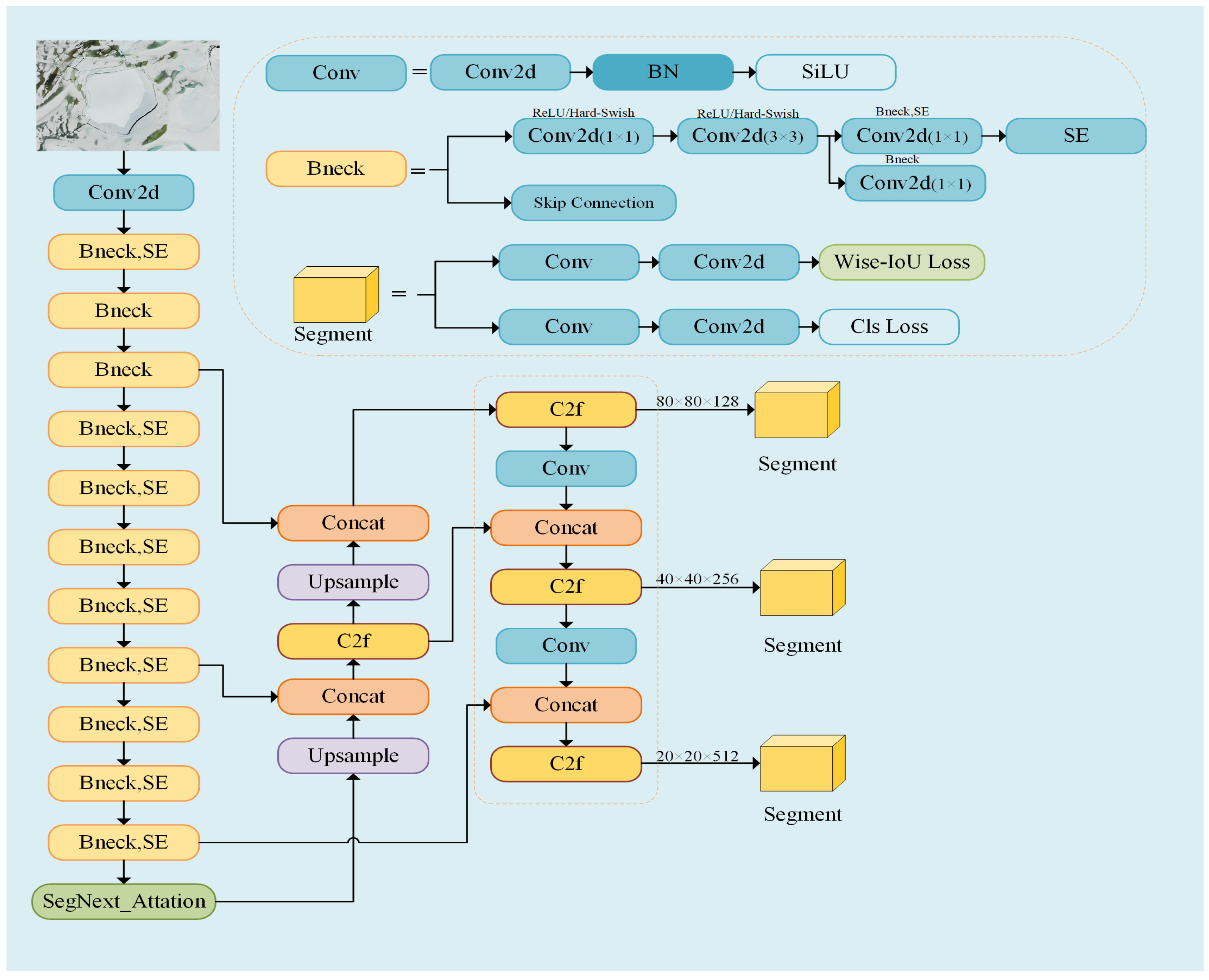
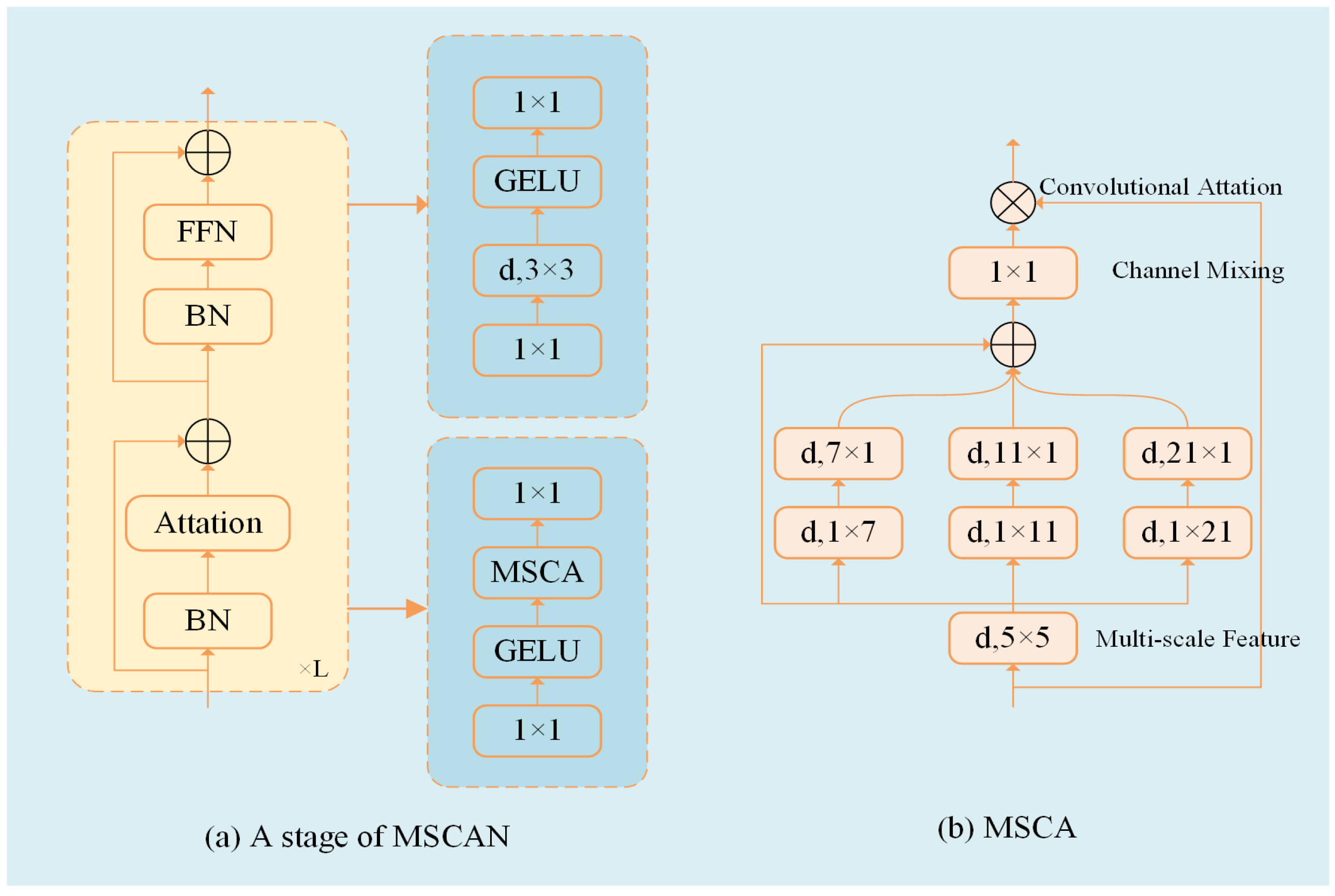
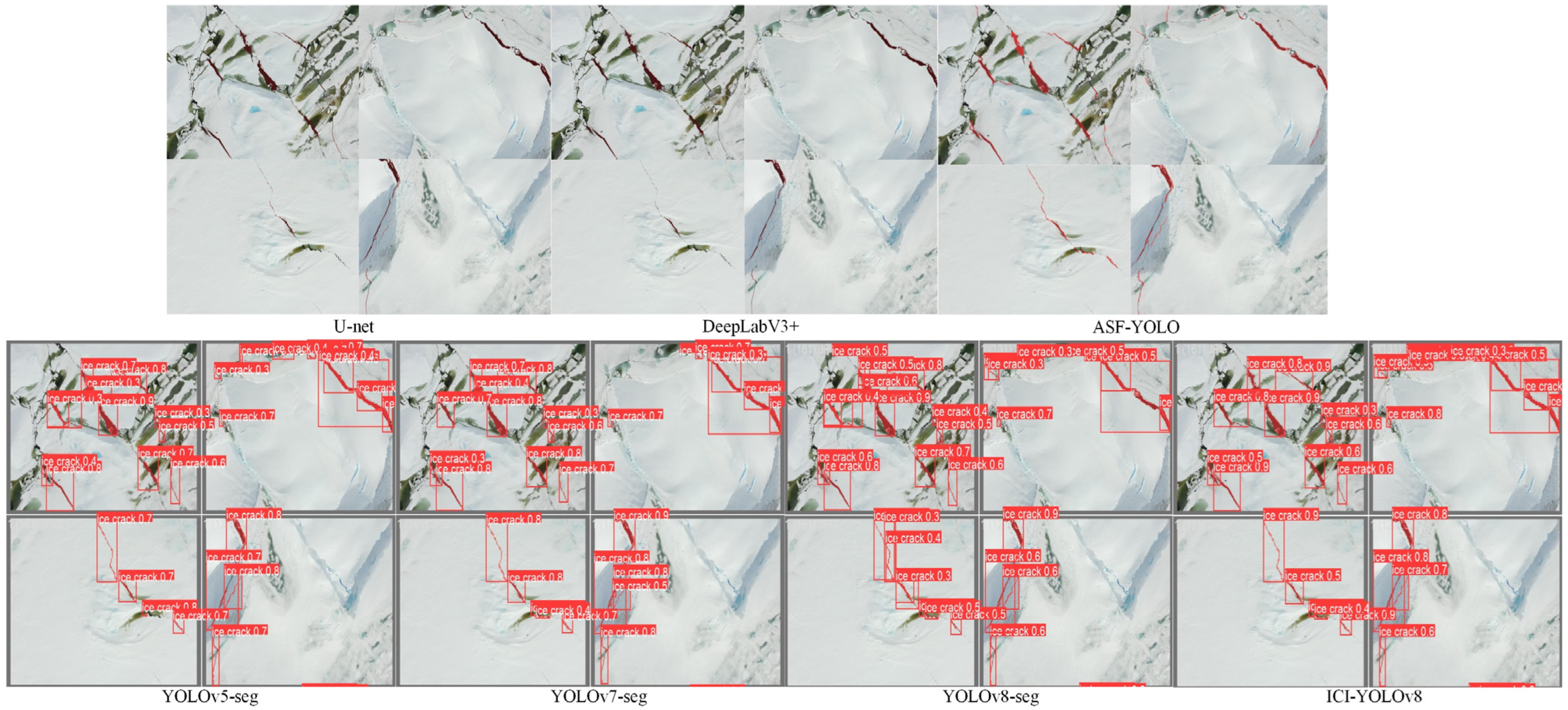
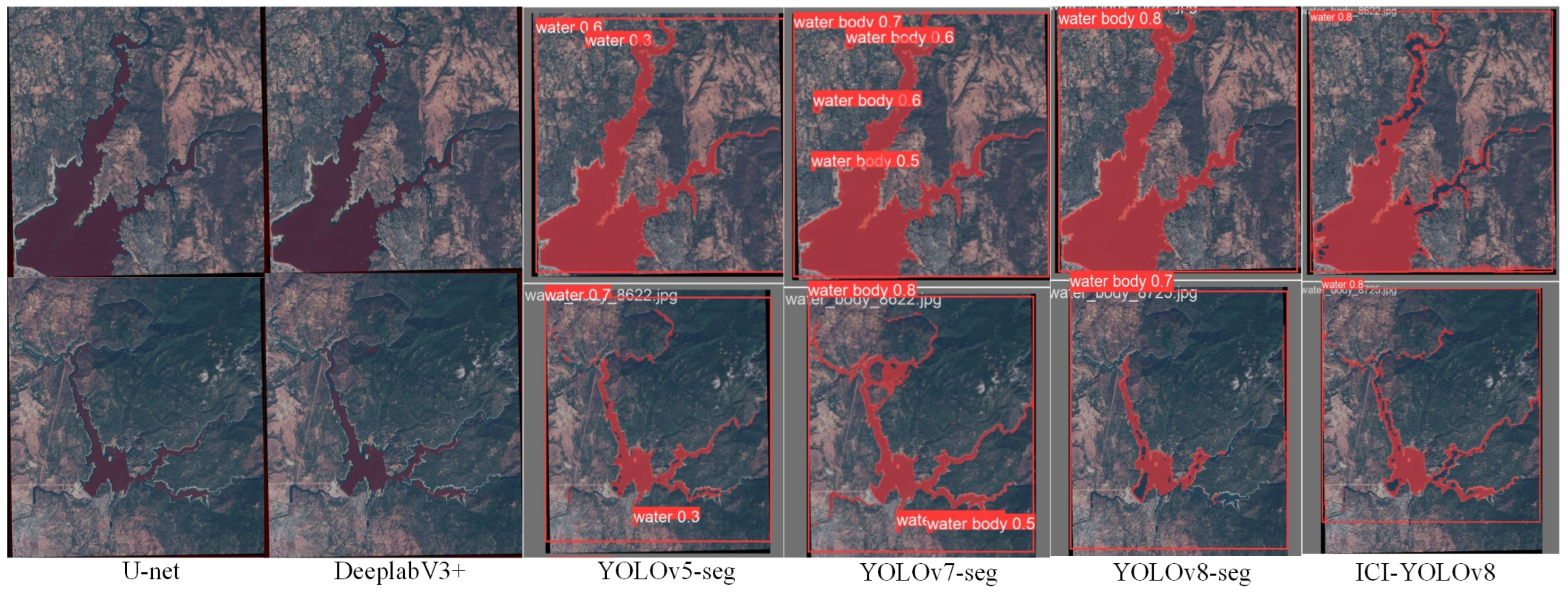
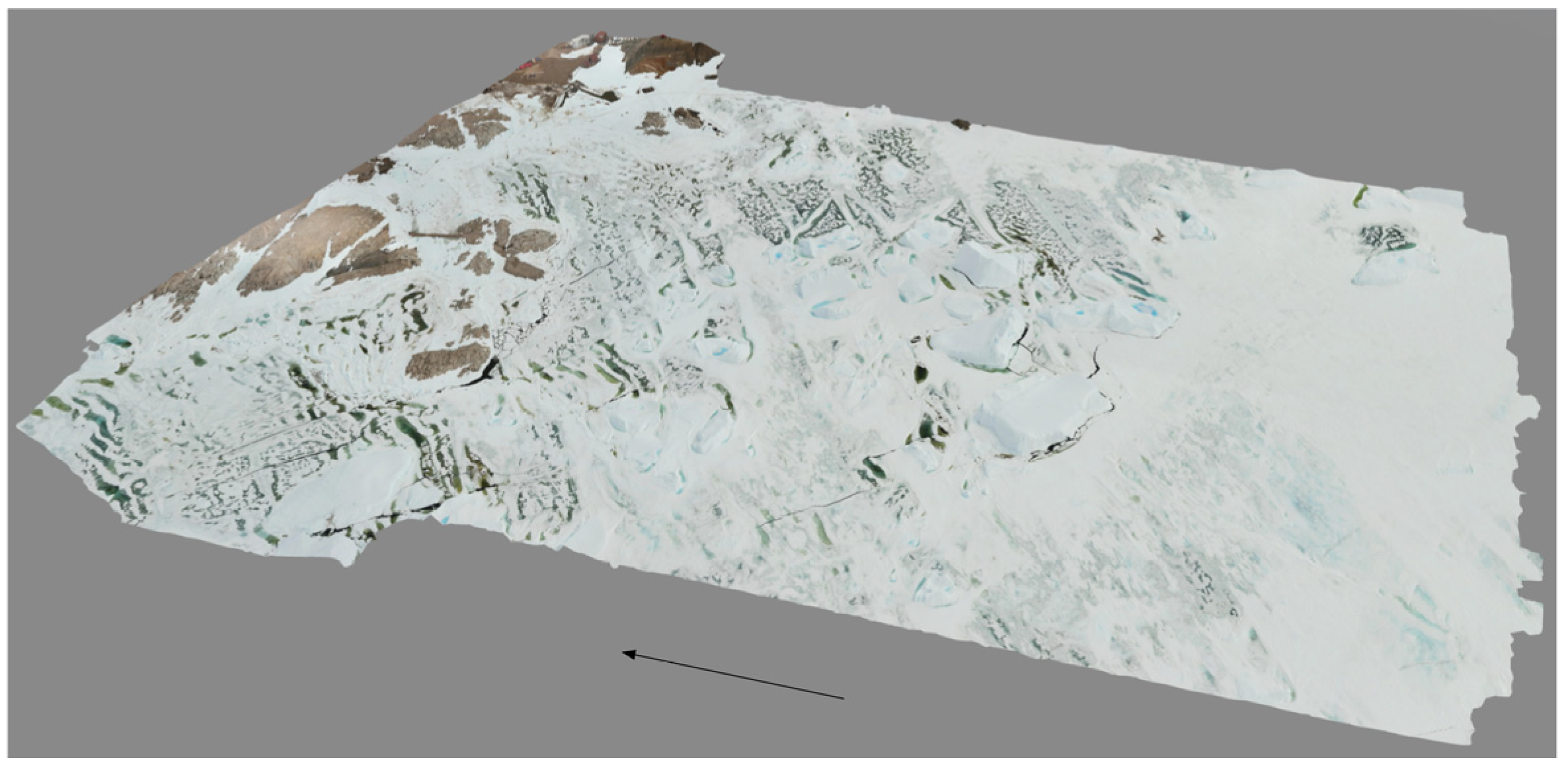

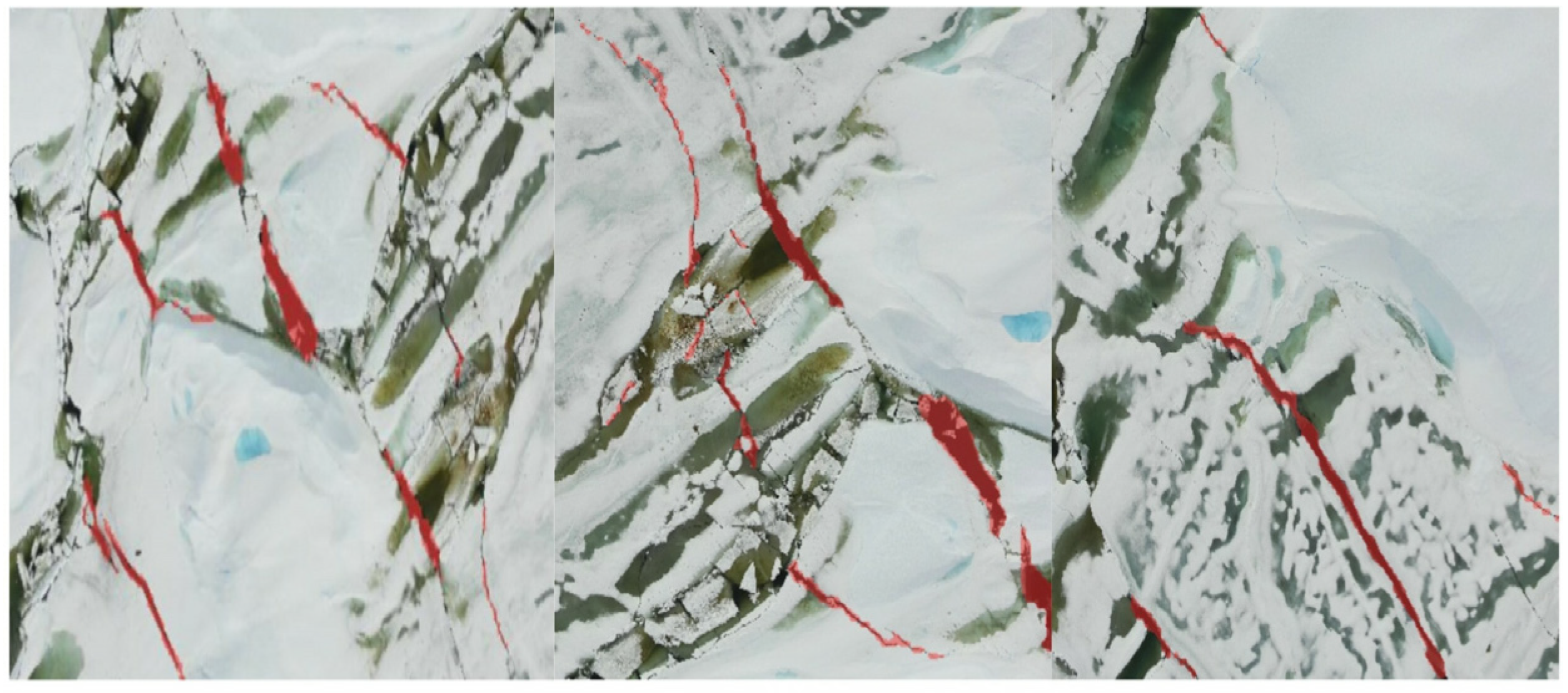
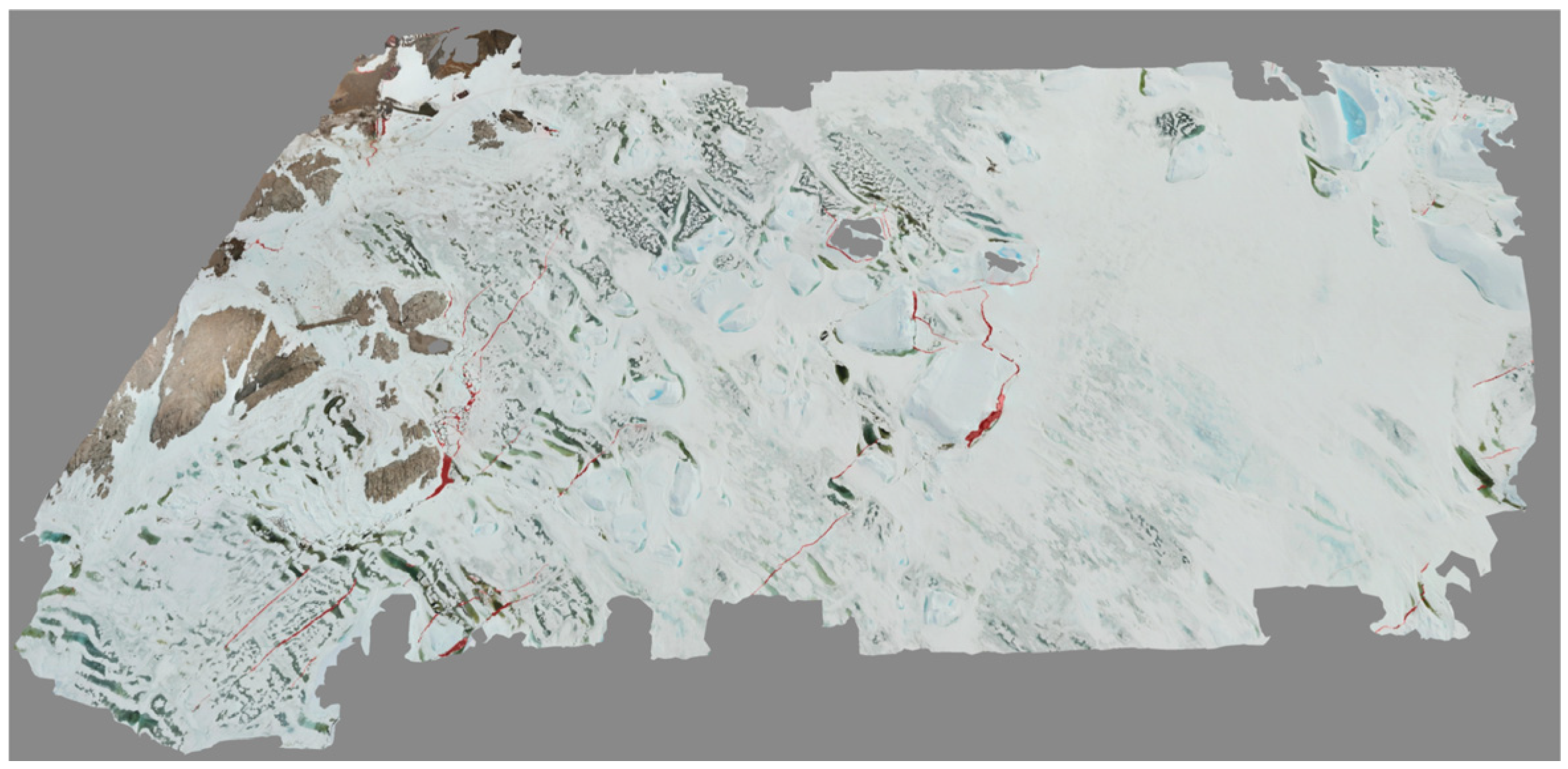
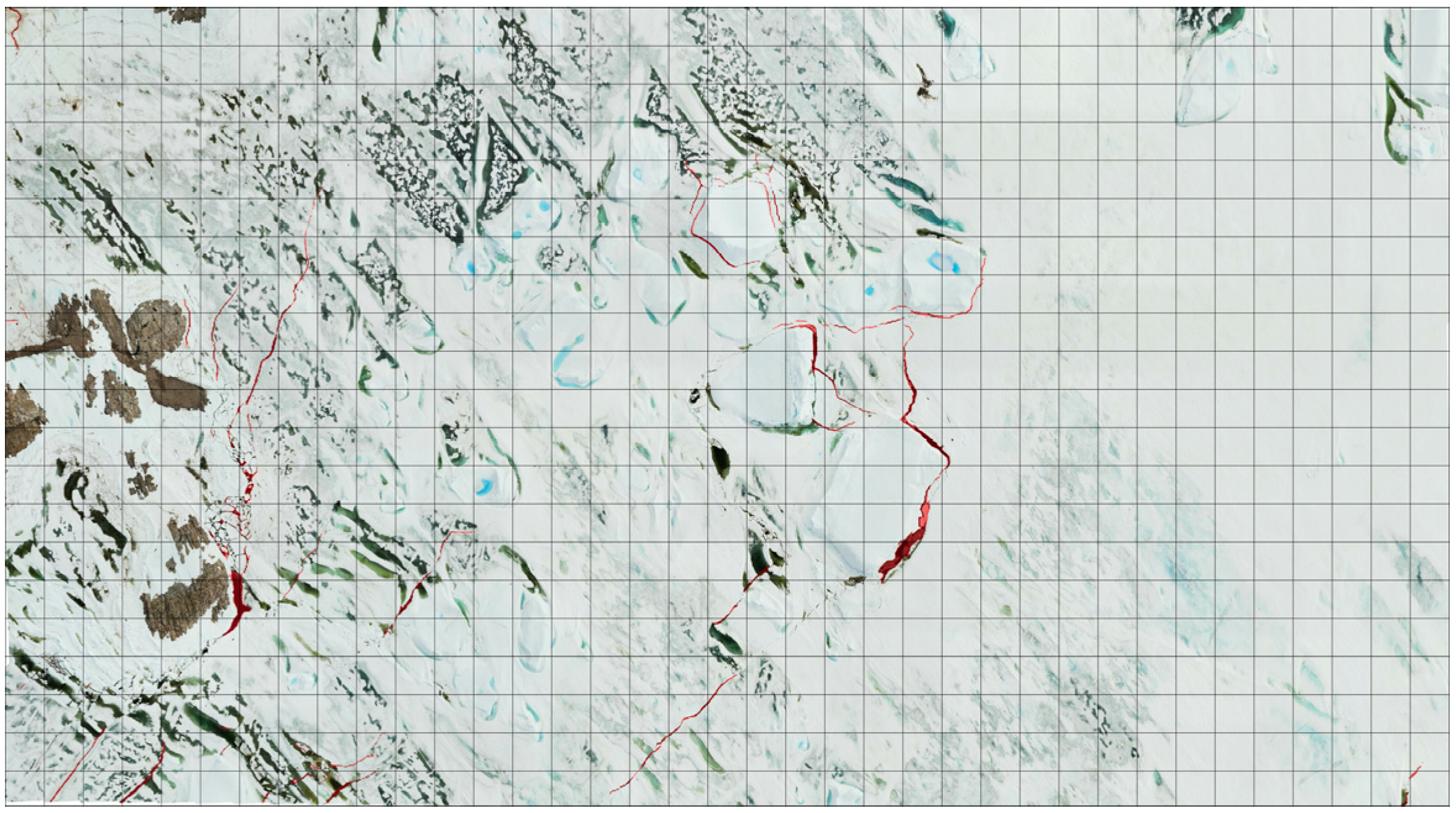
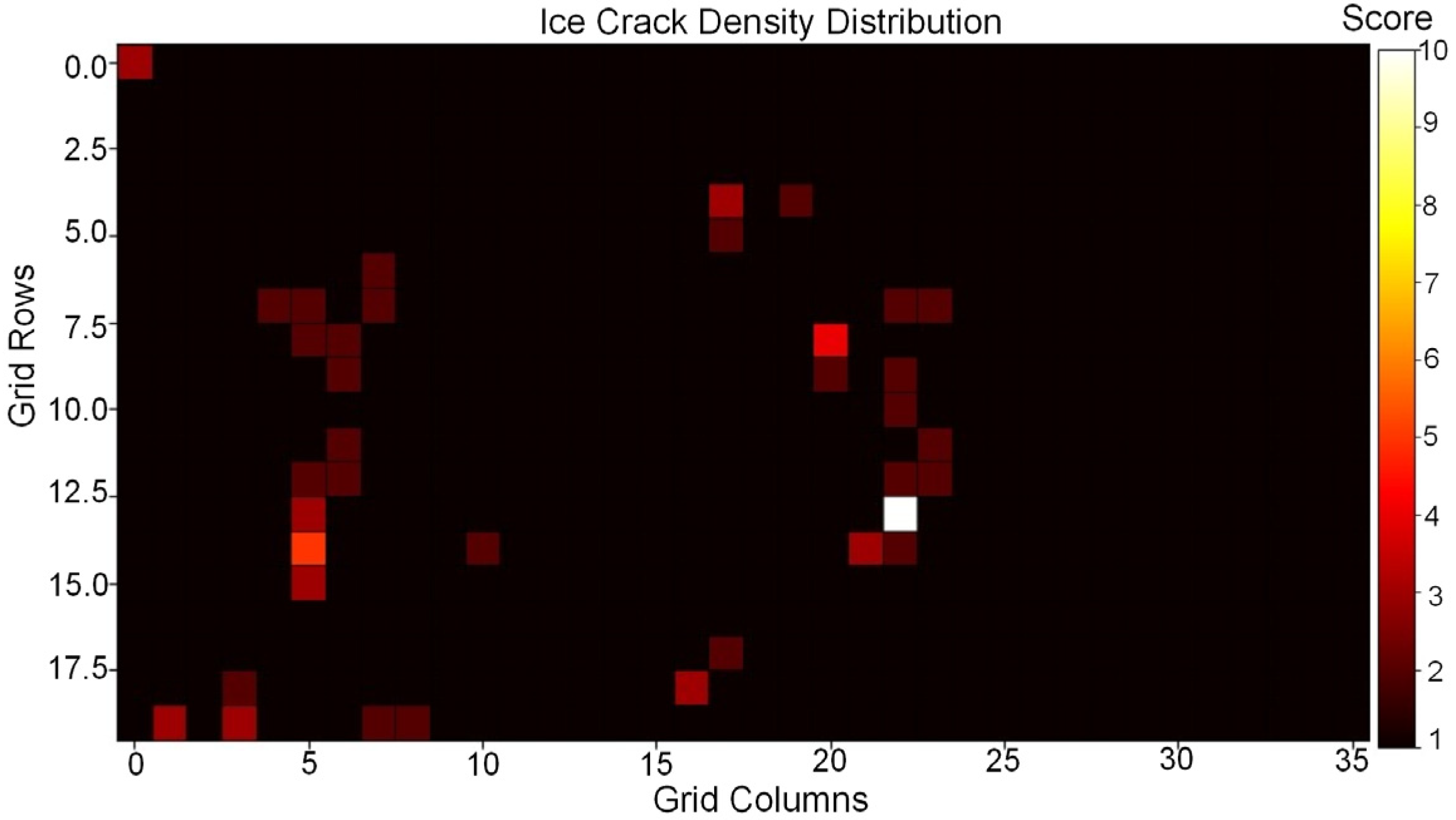
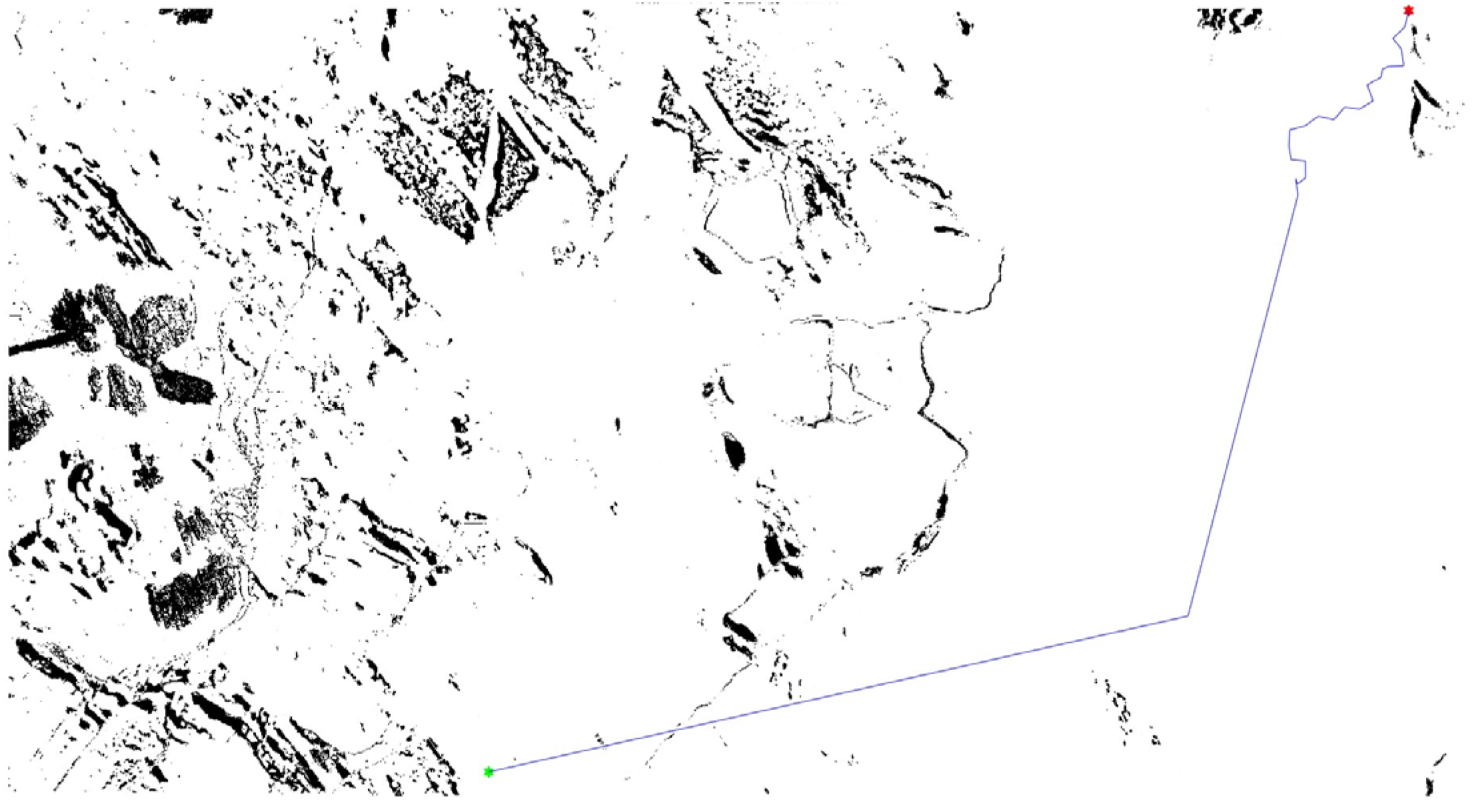
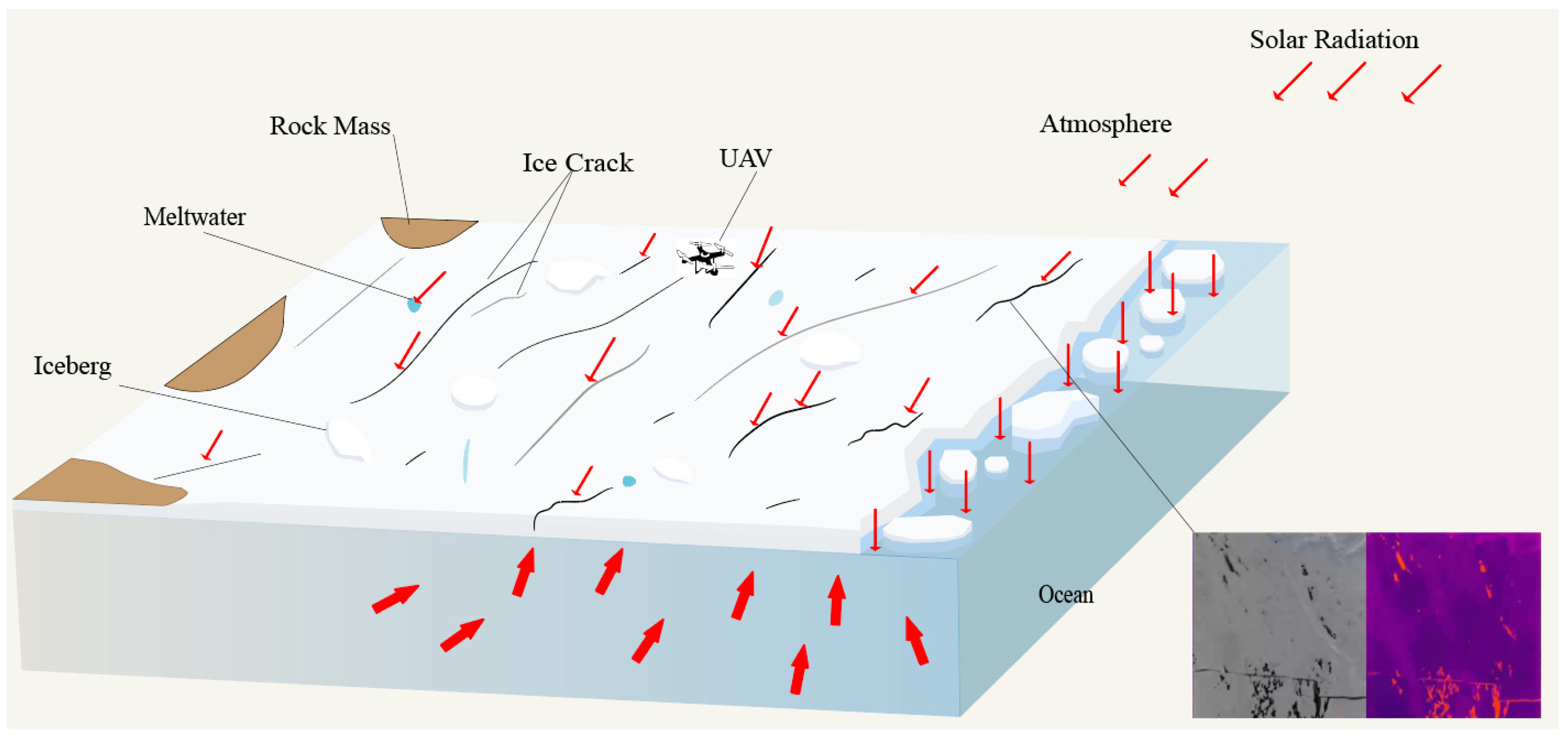

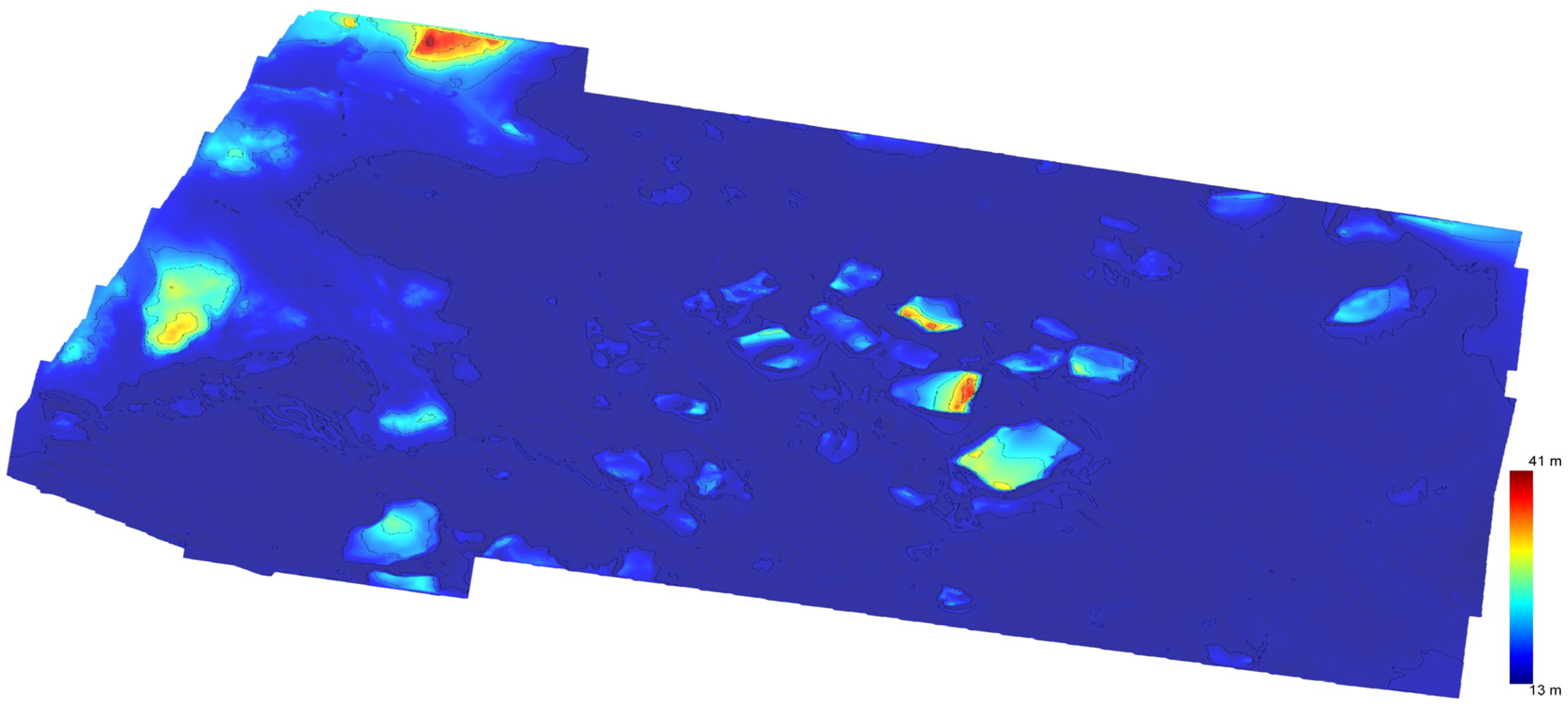

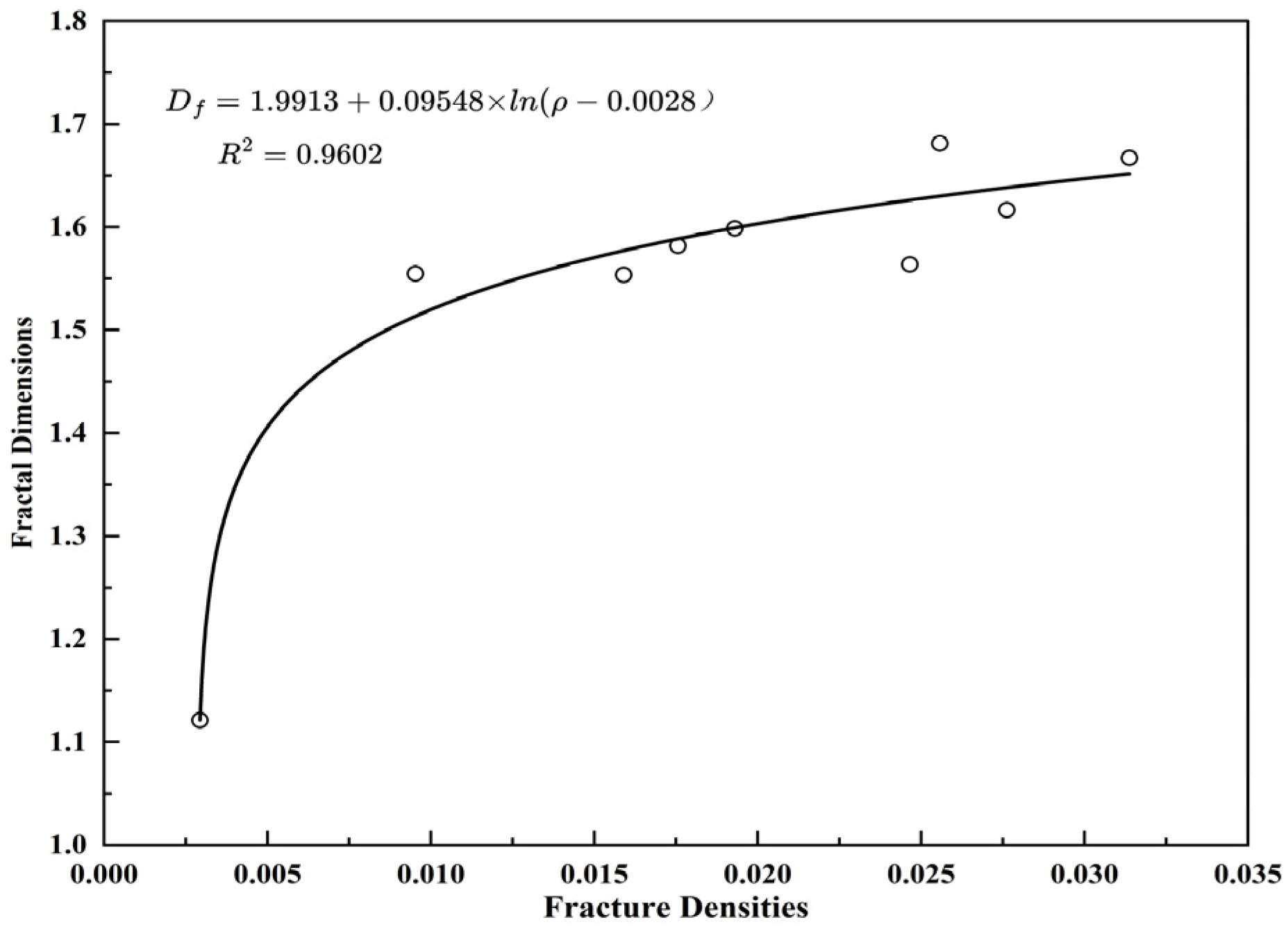
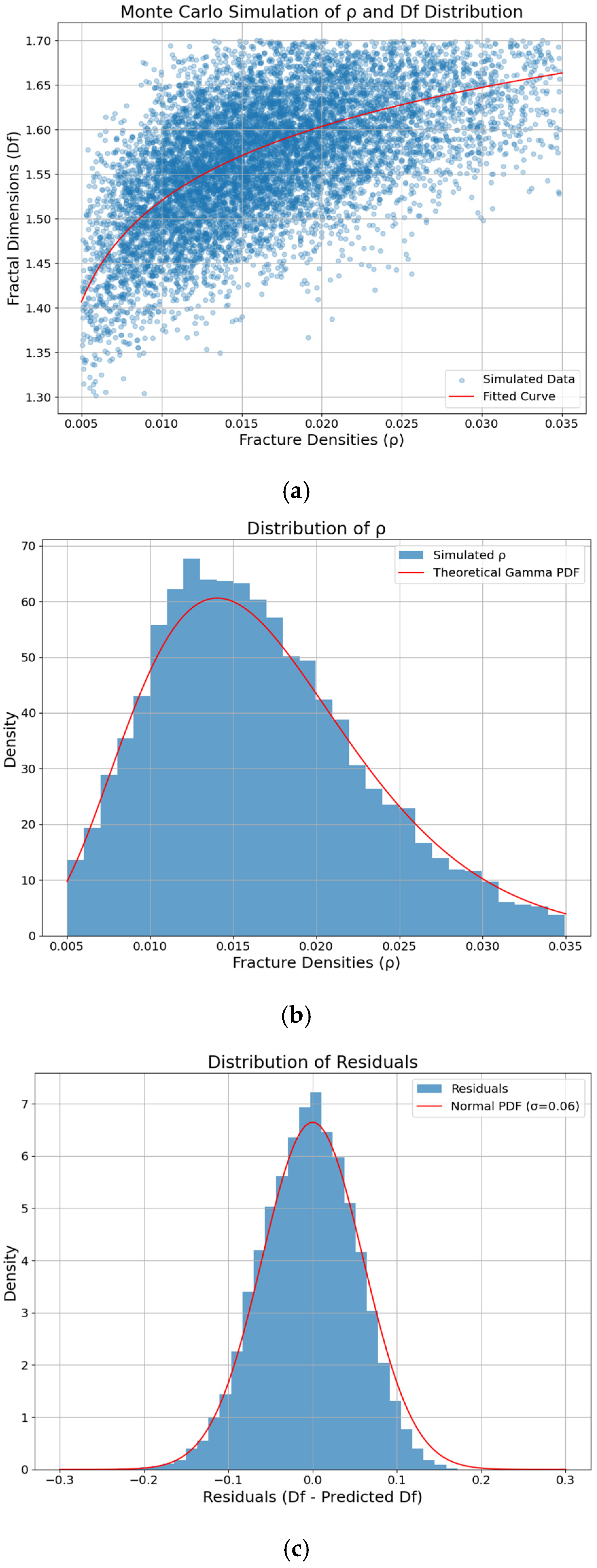

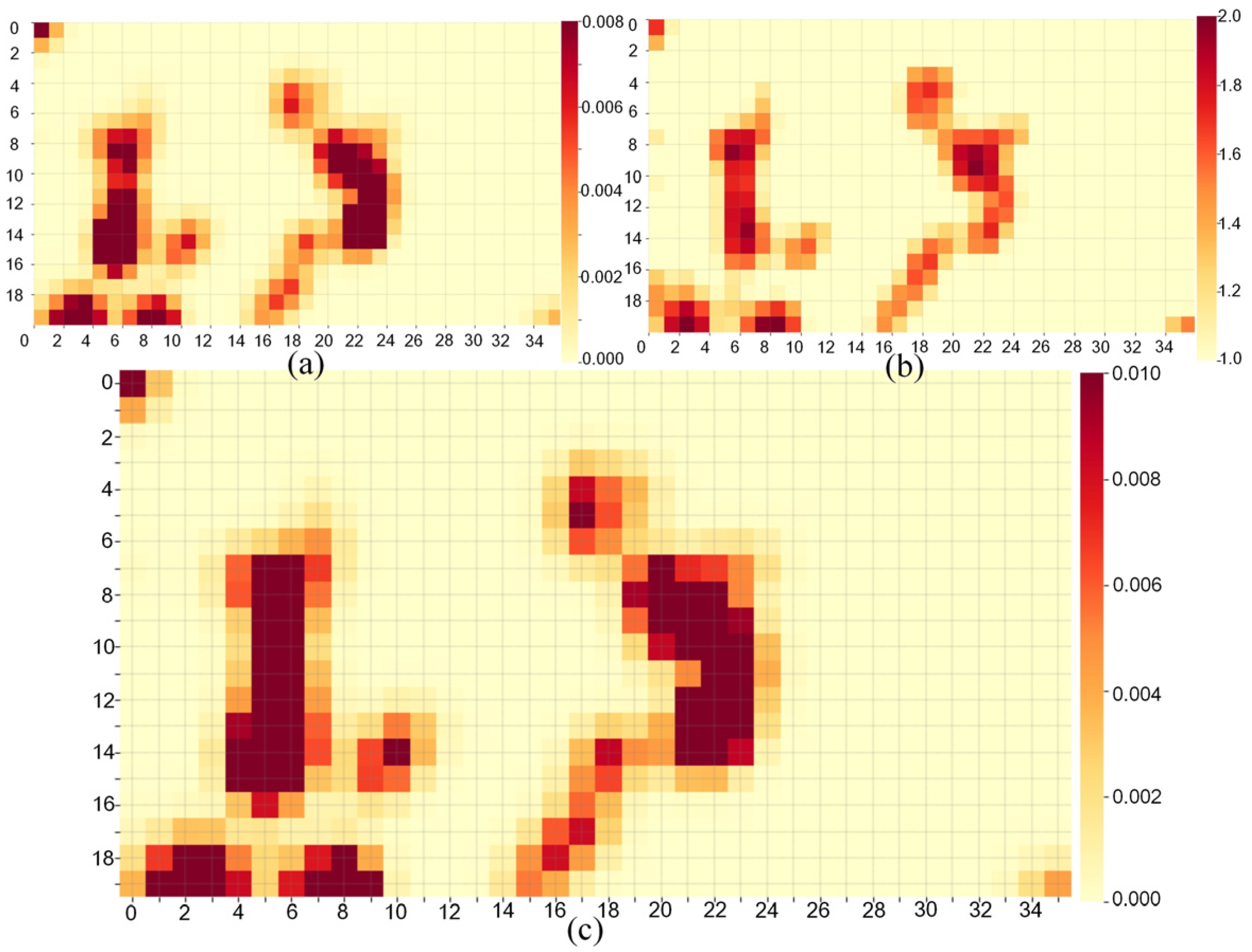

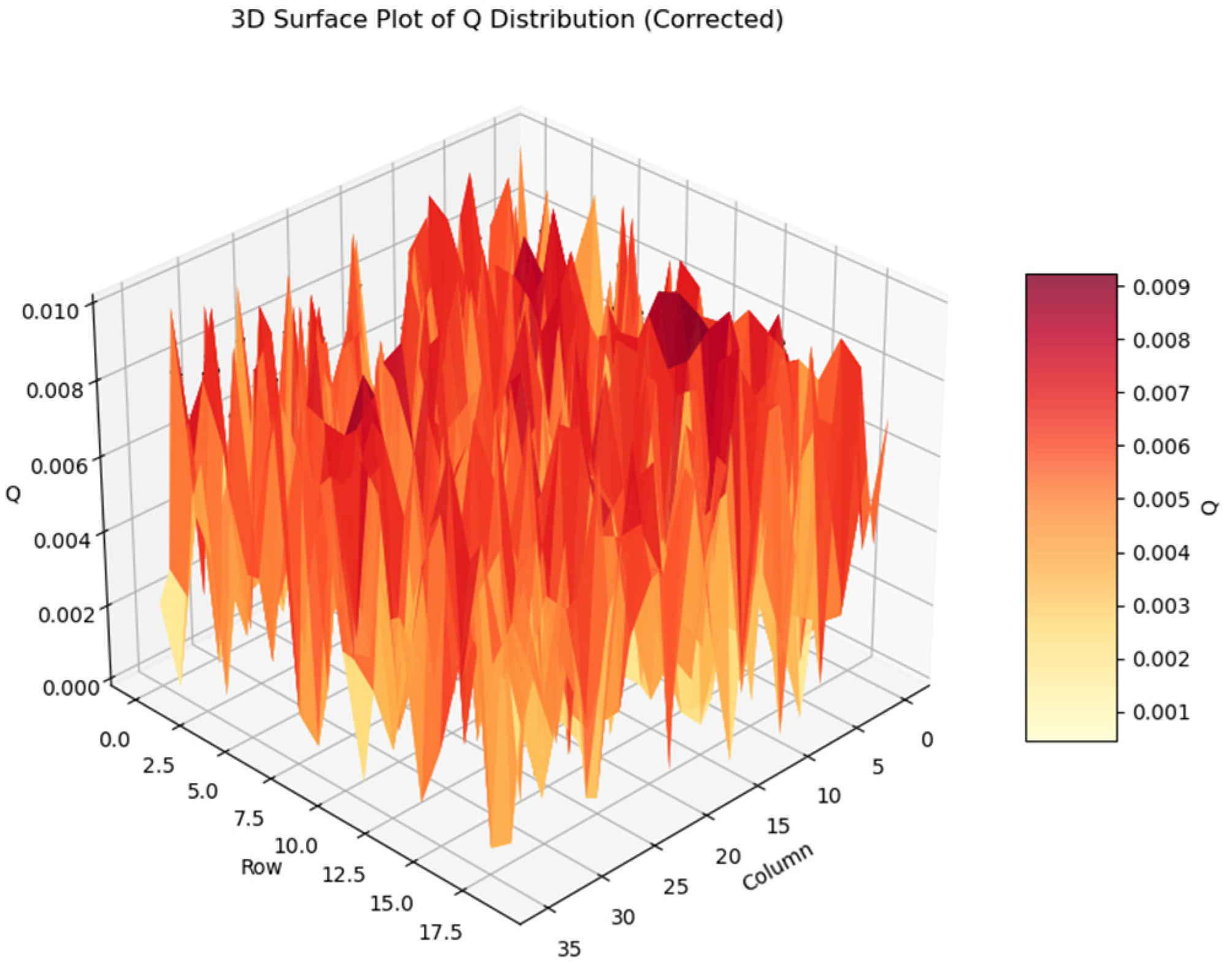
| Platform | Payload | Endurance | GNSS | Output |
|---|---|---|---|---|
| DJI Matrice 350 RTK | DJI Zenmuse P1 | 40 min | RTK, precise | DEM, DTM |
| Model | mPA | mIoU | mDice |
|---|---|---|---|
| U-net [12] | 0.546 | 0.410 | 0.544 |
| DeepLabV3+ [13] | 0.522 | 0.387 | 0.520 |
| Model | mPA | mIoU | mDice |
|---|---|---|---|
| U-net | 0.505 | 0.497 | 0.506 |
| DeepLabV3+ | 0.503 | 0.496 | 0.503 |
| Model | P (Precision) | mAP@0.5 | FPS |
|---|---|---|---|
| YOLOv5-seg | 0.777 | 0.511 | 175.44 |
| YOLOv7-seg | 0.769 | 0.507 | 120.48 |
| YOLOv8-seg | 0.898 | 0.634 | 196.07 |
| ICI-YOLOv8 | 0.933 | 0.657 | 188.67 |
| Model | P (Precision) | R (Recall) | mAP@0.5 | FPS |
|---|---|---|---|---|
| YOLOv8-seg | 0.601 | 0.631 | 0.625 | 47.16 |
| + WIoU | 0.650 | 0.597 | 0.639 | 39.52 |
| + MobileNetv3 | 0.529 | 0.643 | 0.583 | 75.75 |
| + SegNext_Attention | 0.623 | 0.682 | 0.656 | 37.45 |
| + MobileNetv3+ WIoU | 0.569 | 0.543 | 0.556 | 55.25 |
| + SegNext_Attention+ WIoU | 0.570 | 0.698 | 0.647 | 31.15 |
| + MobileNetv3+ SegNext_Attention | 0.600 | 0.698 | 0.654 | 44.44 |
| + All | 0.628 | 0.698 | 0.662 | 40.65 |
| Model | P (Precision) | R (Recall) | mAP@0.5 | FPS |
|---|---|---|---|---|
| YOLOv5-seg [23] | 0.556 | 0.709 | 0.637 | 36.76 |
| YOLOv7-seg [51] | 0.561 | 0.713 | 0.634 | 26.04 |
| YOLOv8-seg [36] | 0.601 | 0.631 | 0.625 | 47.16 |
| ASF-YOLO [28] | 0.607 | 0.651 | 0.654 | 4.67 |
| ICI-YOLOv8 | 0.628 | 0.698 | 0.662 | 40.65 |
| Norm | Average Value | Standard Deviation | Note |
|---|---|---|---|
| All grids ρ | 0.002932 | 0.014895 | - |
| Post-screening ρ | 0.02104 | 0.034293 | Mesh 105 |
| Adjusted Percentile Screening ρ | 0.002931 | 0.004691 | Mesh 360 |
| Df after screening | 1.558 | 0.271 | - |
| Adjusted Df | 1.202 | 0.281 | - |
| ρ and Df correlation coefficients | 0.713 | - | Support for logarithmic relationships |
| Q’s Moran’s I | 0.723 | p-value: 0.01 | Significant spatial autocorrelation |
Disclaimer/Publisher’s Note: The statements, opinions and data contained in all publications are solely those of the individual author(s) and contributor(s) and not of MDPI and/or the editor(s). MDPI and/or the editor(s) disclaim responsibility for any injury to people or property resulting from any ideas, methods, instructions or products referred to in the content. |
© 2025 by the authors. Licensee MDPI, Basel, Switzerland. This article is an open access article distributed under the terms and conditions of the Creative Commons Attribution (CC BY) license (https://creativecommons.org/licenses/by/4.0/).
Share and Cite
Chang, X.; Zhang, L.; Wang, Y.; Li, F.; Yao, X.; Dou, Y. ICI-YOLOv8 Rapid Identification of Antarctic Sea Ice Cracks and Numerical Analysis of Monte Carlo Simulation Under Probability Distribution. Remote Sens. 2025, 17, 3646. https://doi.org/10.3390/rs17213646
Chang X, Zhang L, Wang Y, Li F, Yao X, Dou Y. ICI-YOLOv8 Rapid Identification of Antarctic Sea Ice Cracks and Numerical Analysis of Monte Carlo Simulation Under Probability Distribution. Remote Sensing. 2025; 17(21):3646. https://doi.org/10.3390/rs17213646
Chicago/Turabian StyleChang, Xiaomin, Lulin Zhang, Yuchen Wang, Fuqiang Li, Xu Yao, and Yinke Dou. 2025. "ICI-YOLOv8 Rapid Identification of Antarctic Sea Ice Cracks and Numerical Analysis of Monte Carlo Simulation Under Probability Distribution" Remote Sensing 17, no. 21: 3646. https://doi.org/10.3390/rs17213646
APA StyleChang, X., Zhang, L., Wang, Y., Li, F., Yao, X., & Dou, Y. (2025). ICI-YOLOv8 Rapid Identification of Antarctic Sea Ice Cracks and Numerical Analysis of Monte Carlo Simulation Under Probability Distribution. Remote Sensing, 17(21), 3646. https://doi.org/10.3390/rs17213646






